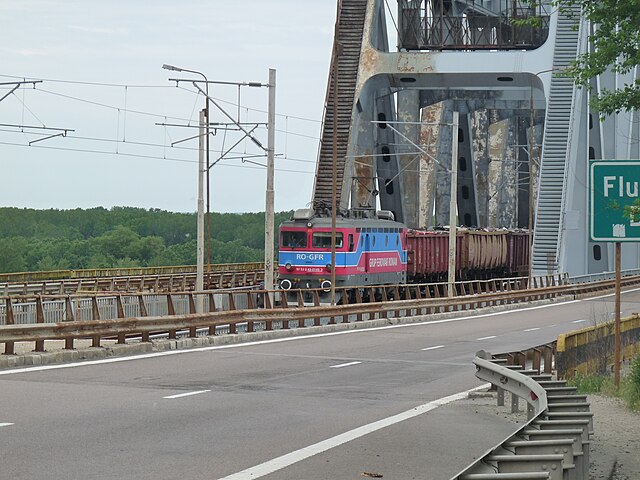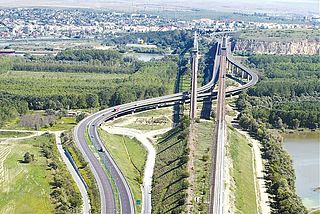A2 motorway (Romania)
Motorway in Romania From Wikipedia, the free encyclopedia
The A2 motorway (Romanian: Autostrada A2), also known as The Motorway of the Sun (Romanian: Autostrada Soarelui), is a motorway in Romania which links Bucharest with Constanța, a city-port on the shore of the Black Sea, where it merges after an interchange into the A4 motorway.[3] It is 206 km long,[1][2] and has been operational on its entire length since November 2012.
| A2 motorway | ||||
|---|---|---|---|---|
 Map of the A2 motorway, as of November 2012 | ||||
 | ||||
| Route information | ||||
| Maintained by Compania Națională de Administrare a Infrastructurii Rutiere | ||||
| Length | 225 km[1][2] (140 mi) | |||
| Existed | 1987–present | |||
| Major junctions | ||||
| West end | Bucharest | |||
| East end | ||||
| Location | ||||
| Country | Romania | |||
| Counties | Ilfov, Călărași, Ialomița, Constanța | |||
| Major cities | Fetești, Cernavodă, Medgidia | |||
| Highway system | ||||
| ||||





History
Summarize
Perspective
The construction of the motorway between Bucharest and Constanța began in the communist era during Nicolae Ceaușescu's regime. The first section, from Fetești to Cernavodă (about 18 km), was opened on 21 November 1987, simultaneous to the new railway bridge and underwent a major rehabilitation in 2003. It crosses the Balta Ialomiței island and includes the Cernavodă Bridge complex system of motorway and railway bridges and viaducts over the Danube and one of its branches at Cernavodă. The motorway bridge passes under the historical railway bridge built by Anghel Saligny in 1895, while the new railway in use today separates the motorway roadways.
After the fall of the communism in 1989, construction continued for a short period, but it was finally stopped in 1993 due to lack of financial resources. When it was completed, it differed from the original plans from the 70s. The original plan of the A2 motorway envisaged a route running northwards through Urziceni and Slobozia, while the current route of the motorway runs eastwards in a straight line towards Fetești. Construction continued after 1998, the motorway being completed in late 2012.
The sector from Bucharest to Fetești crosses the Bărăgan Plain and was built between 2001 and 2007. It was split into four sections. The first section from Bucharest to Fundulea (26.5 km) was built by the Romanian company Romis and is surfaced with concrete slabs. The second section from Fundulea to Lehliu (29.2 km) was built by a Turkish joint venture between Yuksel, Makimsar and Ener, while the third section from Lehliu to Drajna (41.6 km) was built by the French company Colas. The three sections were completed in 2004.[4] The fourth, from Drajna to Fetești (36.8 km), was built by a joint venture between Astaldi, Max Bögl and CCCF, and was completed in 2007, receiving financial support from the ISPA funds.[5]
The sector from Cernavodă to Constanța (51.3 km) runs across the Dobruja Plateau and was built between 2009 and 2012, receiving financial resources from the European Union's Cohesion Fund and from the European Investment Bank. It was built by a joint venture between Astaldi and Max Bögl, and was completed in late 2012.[6] The section from Cernavodă to Medgidia was initially awarded to the French company Colas, but the contract was terminated in April 2011, because of delays in the construction process.[7] It was subsequently awarded to the new constructor in September 2011.[8]
The total distance between Bucharest and Constanța on the motorway is approximately 206 km.[1][2] It includes a 3.8 km link segment at the eastern end,[9][10] that was part of the construction contract for the A4 motorway,[11] which serves as the Constanța bypass. It has seven exits and ten rest areas on each carriageway, six being served by filling stations. There is one toll gate along the route, at Fetești (km 144), where a tax is charged for crossing the Danube bridges.[12][13]
During summer, heavy traffic (maximum permissible weight over 7.5 t) is forbidden to drive on the motorway on weekends (including Friday) at daylight hours (from 6 A.M. to 12 A.M.).[14]
Openings timeline
- In 21 November 1987, the 17.2 km segment Fetești – Cernavodă was opened for traffic. The segment was closed for traffic again in September 2006 for complete rebuilding and reopened in 2007.
- On 4 June 2004, two segments opened for traffic: Bucharest – Fundulea (26.5 km) and Fundulea – Lehliu (29.2 km).
- In November 2004, the 42 km segment Lehliu – Drajna was opened for traffic.
- In June 2006, the 17.2 km segment Fetești – Cernavodă was re-opened for traffic, after major rehabilitation works.
- Between 1 July and 15 September 2006, the 36.8 km segment Drajna – Fetești temporarily opened for traffic in both ways but only on one carriageway.
- On 1 May 2007, the 36.8 km segment Drajna – Fetești was re-opened for traffic.
- On 29 July 2011, the Murfatlar – Constanța segment (21 km, including a part of A4) was inaugurated (initially, on two of the total four lanes).[15]
- On 30 September 2011, the Murfatlar – Constanța segment was completed and opened on both carriageways.[16]
- On 19 July 2012, the Cernavodă – Medgidia segment (20.5 km) was opened for traffic on a single carriageway, and the Medgidia – Murfatlar segment (16.3 km) was opened on both carriageways.[17]
- On 29 November 2012, the Cernavodă – Medgidia segment (20.5 km) was opened for traffic on both carriageways.[18]
Exit list
| County | Location | km | mi | Destinations | Notes |
|---|---|---|---|---|---|
| City of Bucharest | 11 | 6.8 | Theodor Pallady Boulevard | Western terminus. Introductory path of the A2. Distance is measured from the Kilometer Zero monument in Bucharest. | |
| 12 | 7.5 | ||||
| Ilfov | Cernica | 14 | 8.7 | The A0 motorway is planned to go towards | |
| 18 | 11 | Opened in 2015. | |||
| Brănești | 22 | 14 | Opened in 2021. | ||
| Călărași | Fundulea | 35 | 22 | ||
| | 48 | 30 | Rest area: OMV | ||
| Lehliu Gară | 64 | 40 | |||
| 66 | 41 | Rest area: Petrom | |||
| | 74 | 46 | Parking | ||
| | 88 | 55 | Rest area: Rompetrol | ||
| | 98 | 61 | Parking | ||
| Drajna | 105 | 65 | |||
| | 111 | 69 | Rest area: OMV | ||
| | 120 | 75 | Parking | ||
| | 131 | 81 | Parking | ||
| Ialomița | | 139 | 86 | Rest area: Rompetrol | |
| Fetești | 142 | 88 | Rebuilt in 2007. | ||
| 144 | 89 | ||||
| 145 | 90 | Fetești Bridge | The Fetești Bridge crosses over the Borcea branch of the Danube. | ||
| 146 | 91 | U-turn exit | |||
| Constanța | Cernavodă | 157 | 98 | U-turn exit | Eastbound only. |
| 158 | 98 | Cernavodă Bridge | The Cernavodă Bridge crosses over the Danube. | ||
| 160 | 99 | Reconfigured as exit in 2012. | |||
| Medgidia | 192 | 119 | |||
| 196 | 122 | Rest area: MOL | MOL filling station opened in 2022.[19] | ||
| Constanța | 205 | 127 | Parking | ||
| 212 | 132 | Eastern terminus. Road continues as A4 to | |||
1.000 mi = 1.609 km; 1.000 km = 0.621 mi
| |||||
See also
References
External links
Wikiwand - on
Seamless Wikipedia browsing. On steroids.

